My home on the web
Site Index
The Synodic Period of Venus
Introduction
A sky object's synodic period is the time between repeated appearances of that object, as seen from the Earth, in the same position with respect to the Sun. Venus' synodic period takes about 584 days (actually 583.92 days). The following table shows each phase, beginning with a re-appearance of Venus as the morning star, a heliacal rising, after a period of being aligned with the Sun and therefore lost in solar glare.
The first column is the orbital view, which shows the orbits of the Earth and Venus and the position of the two planets at that point in the cycle, as seen from north of the Earth's orbit. The second column is the horizon view, which shows what an observer on Earth would see either just before sunrise in the east, or just after sunset in the west. The third column gives the day number and comments about this phase of the synodic period. The day number for each phase (except the first and last) are approximate; the middle phases can occur one or two days earlier or later.
In the orbital view, the blue dot marks the position of the Earth, the white dot marks the postition of Venus, the yellow ball is the Sun, and the circles represent the orbital paths of the planets. The planets orbit the Sun in a counter-clockwise direction as shown by the arrow in the bottom right corner of each image. The green part of the orbit circle shows the movement of the planet from the previous to the current phase of the synodic period.
In the horizon view, the black bar represents the horizon, the yellow glow represents the sunrise or sunset, and the white dot marks the position of Venus in the sky. The view shown is either the eastern (morning) sky at sunrise or the western (evening) sky at sunset. It assumes ideal observing conditions: a flat, unobstructed horizon, a cloudless sky and dry air.
Aspects of the Synodic Period of Venus
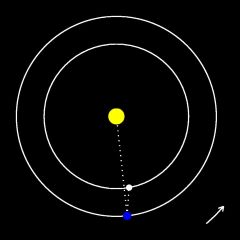

Venus has moved just far enough ahead of the Earth in its orbit so that it re-appears in the morning sky and begins a new synodic period. At this point, Venus is about 10 degrees from the Sun and could be seen by careful observation just before the Sun rises in the east. Venus then rises earlier and earlier each day, getting further and further ahead of the Sun, and higher and higher in the sky at sunrise, until ...
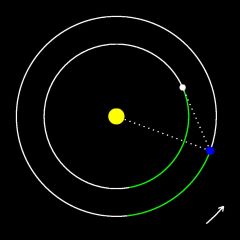
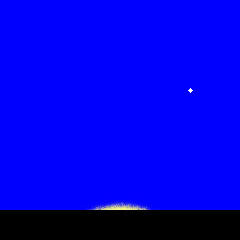
Venus is about 46 degrees ahead of the Sun in the morning sky. Now it begins to rise later each day, moving back toward the Sun's glare at sunrise until ...
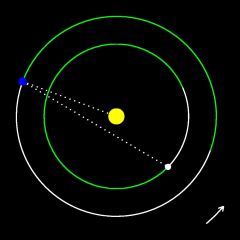

Venus makes its last appearance as the morning star. Now it begins to move behind the Sun as seen from the Earth, and so becomes hidden from view.
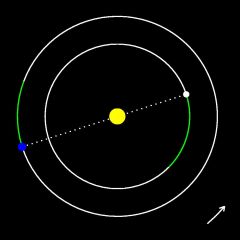

Venus is behind the Sun and cannot be seen from the Earth. This point is called superior conjunction.


Venus has moved far enough away from the Sun to be seen again, this time as the evening star. At this point, Venus is about 10 degrees from the Sun and could be seen by careful observation just after the Sun sets in the west. Venus then sets later and later each day, getting further and further behind the Sun, and higher and higher in the sky at sunset, until ...
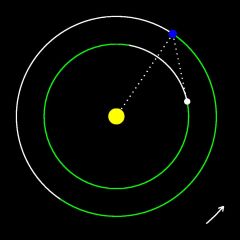

Venus is about 46 degrees behind the Sun in the evening sky. Now it begins to set earlier each day, moving back toward the Sun's glare at sunset until ...
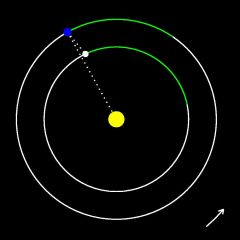

Venus makes its last appearance as the evening star. Now it begins to move in front of the Sun as seen from the Earth, and so becomes hidden from view.
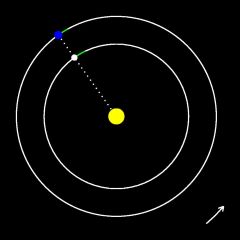

Venus is in front of the Sun and cannot be seen from the Earth. This point is called inferior conjunction.
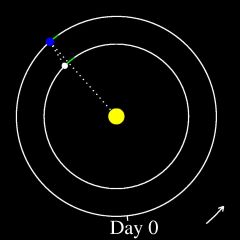

Venus re-appears in the morning sky, ending the previous synodic period and beginning the next. But note that the Earth has moved through one full orbit (one year or about 365 days) and three-fifths of another (about 219 days). In that same time, Venus has moved through two of its own orbits and three-fifths of another.
Copyright 2020 Dale A. Dellutri
Last modified: Saturday, 09-May-2020 16:14:27 EDT